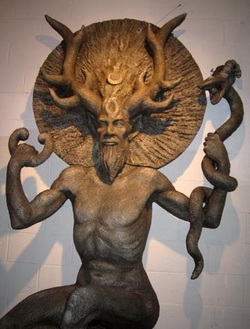
I've been fascinated by the figure of the horned god ever since I began to encounter representations of him in cave art. I think we can immediately conclude without hesitation the image of the horned god is essentially a relative manifestation of the principle oft he absolute aspect of nature. In all religions this is the only means we as human beings can really hope to interact with universal, transcendental and elemental forces; in this case a powerful manifestation of the natural world, the forests, caves, woods and waterways. In an absolute sense the figure of Cernunnos IS nature, that primal force we get a strong sense of whenever we go for a walk in the woods, hills or by the ocean. In a relative sense, how do we hope to interact with that-I hesitate to use that derelict new age term but I guess there isn’t a better alternative-'energy?' We visualise it through the manifestation of the horned god, a representation of a merging of our human selves with in its devotional aspect and endeavour to contact him through ritual.
Its an attempt to make the unknowable knowable, to personalise an
impersonal, hostile and remote universe. I sincerely believe this is what we
are seeing in all the great cave art. There is ample evidence to suggest that
the origin of much cave art is from ritual activity undertaken by shamans and
spiritual journeyers, and is in essence a figurative representation of the
images seen in trance states. The figure of 'The Sorcerer' from trois frerrer
is I believe a fine example of this principle at work. Its here we can possibly
hope to find the birthplace of figures like the horned god Cernunnos. (For more see Graham
Hanckock:Supernatural)
As we can say with certainty that cave art really began
to appear on the landscape during the late Palaeolithic, then we can speculate
with some confidence that this is the period when we as a species began to
spiritually and devotionally attempt to merge ourselves with the awesome
elemental power of the natural world around us and the creatures we shared it
with through acts of devotional representation and activity. There exists a
wealth of anecdotal evidence to support this, particularly in anthropological
literature concerning the spiritual behaviour of the American plains Indians
and extant hunter-gatherer societies in the rain forests of South America. A
problem is that now, being modern humans and focusing our not inconsiderable
ego's, neurotic and self aggrandising agendas onto figures like Cernunnos we
have lost site of this primal relationship and replaced it with needy midnight
conjuring and delusional, narcissistic neo pagan mumbling. If we want to see
the consequences of losing site of what Cernunnos really is, of what Herne the
Hunter really embodies, then we should watch the Werner Herzog documentary
'Grizzly Man' about the hopelessly misguided and delusional Timothy Treadwell.
Admirable ethical concerns are one thing, (and I heartily support anyone’s efforts to highlight
abuses of the natural world and the species we share it with) a delusional and
hopelessly romantic view of the natural world warped by sentimental new age
agendas is another.
It’s right here, in a primal, Palaeolithic landscape
where I believe we can find the true origins of Cernunnos, and the very ancient
source of our fascination with the horned god. We will not find him in a weekend
drumming workshop or a store in Glastonbury.
For Palaeolithic hunter-gatherers the world was a
dangerous and spiritually elevated environment. (There is now evidence to
suggest that Palaeolithic man lived his urgent life in an elevated state of
consciousness, and was therefore much more open and receptive to states of being
utterly lost to us in our everyday lives. On a subconscious level we do recognise this impulse,
its what drives us into the forest and the hills on a day off. Its what
motivates us to seek out a spiritual aspect to our lives.)
When Palaeolithic man stared at the interior of the forest and asked questions, it
was the horned god who stepped out to answer him. Their relationship with the
natural world (a relationship that fascinates me as it is so removed from the
distant irregular and abusive one we share with our planet) and their attempts
to commune with it gave birth to the figure of the horned god.
It is out in the wilds, and in a transcendental inner
landscape beyond the everyday, relative workings of the mind, that is where we
will find him.
 RSS Feed
RSS Feed
